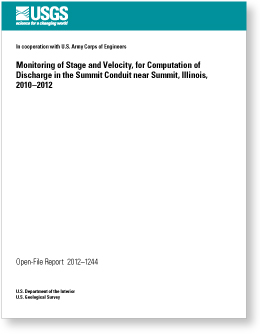 Abstract Abstract
Lake Michigan diversion accounting is the process used by the U. S. Army Corps of Engineers to quantify the amount of water that is diverted from the Lake Michigan watershed into the Illinois and Mississippi River Basins. A network of streamgages within the Chicago area waterway system monitor tributary river flows and the major river flow on the Chicago Sanitary and Ship Canal near Lemont as one of the instrumental tools used for Lake Michigan diversion accounting. The mean annual discharges recorded by these streamgages are used as additions or deductions to the mean annual discharge recorded by the main stream gaging station currently used in the Lake Michigan diversion accounting process, which is the Chicago Sanitary and Ship Canal near Lemont, Illinois (station number 05536890).
A new stream gaging station, Summit Conduit near Summit, Illinois (station number 414757087490401), was installed on September 23, 2010, for the purpose of monitoring stage, velocity, and discharge through the Summit Conduit for the U.S. Army Corps of Engineers in accordance with Lake Michigan diversion accounting. Summit Conduit conveys flow from a small part of the lower Des Plaines River watershed underneath the Des Plaines River directly into the Chicago Sanitary and Ship Canal. Because the Summit Conduit discharges into the Chicago Sanitary and Ship Canal upstream from the stream gaging station at Lemont, Illinois, but does not contain flow diverted from the Lake Michigan watershed, it is considered a flow deduction to the discharge measured by the Lemont stream gaging station in the Lake Michigan diversion accounting process. This report offers a technical summary of the techniques and methods used for the collection and computation of the stage, velocity, and discharge data at the Summit Conduit near Summit, Illinois stream gaging station for the 2011 and 2012 Water Years.
The stream gaging station Summit Conduit near Summit, Illinois (station number 414757087490401) is an example of a nonstandard stream gage. Traditional methods of equating stage to discharge historically were not effective. Examples of the nonstandard conditions include the converging tributary flows directly upstream of the gage; the trash rack and walkway near the opening of the conduit introducing turbulence and occasionally entraining air bubbles into the flow; debris within the conduit creating conditions of variable backwater and the constant influx of smaller debris that escapes the trash rack and catches or settles in the conduit and on the equipment. An acoustic Doppler velocity meter was installed to measure stage and velocity to compute discharge. The stage is used to calculate area based the stage-area rating. The index-velocity from the acoustic Doppler velocity meter is applied to the velocity-velocity rating and the product of the two rated values is a rated discharge by the index-velocity method. Nonstandard site conditions prevalent at the Summit Conduit stream gaging station generally are overcome through the index-velocity method. Despite the difficulties in gaging and measurements, improvements continue to be made in data collection, transmission, and measurements. Efforts to improve the site and to improve the ratings continue to improve the quality and quantity of the data available for Lake Michigan diversion accounting.
|
First posted July 2, 2013
Part or all of this report is presented in Portable Document Format (PDF); the latest version of Adobe Reader or similar software is required to view it. Download the latest version of Adobe Reader, free of charge. |